|
Images of Wales Back to Webpage Archive
The feature below was first shown on my website on 17 May 2004

Images of Wales
18th and 19th Century Prints of South and West Wales
Page 4
Breconshire Cardiganshire Carmarthenshire Glamorgan Monmouthshire Pembrokeshire
Page 1 Page 2 Page 3
Glamorgan (continued)
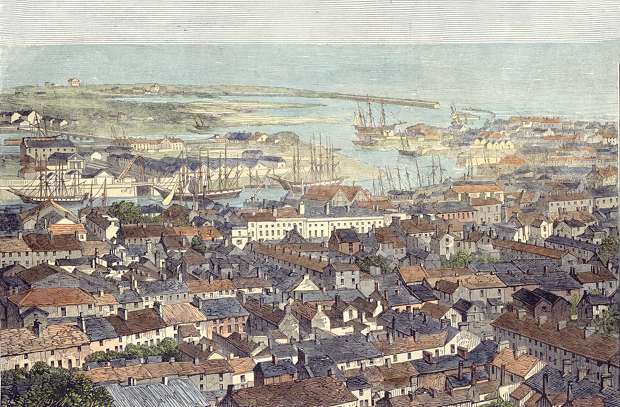
Hand-coloured wood engraving by Smyth (from a Daguerreotype), in Illustrated London News 19 Aug 1848 |
| Above: Swansea Town. This town, claiming to be regarded as the most important in South Wales, is advantageously and beautifully situated, between two lofty hills, on the western bank of the Tawe, which is navigable for ships of large burden, and in the centre of a noble bay to which it gives its name. (Black, 1869) |
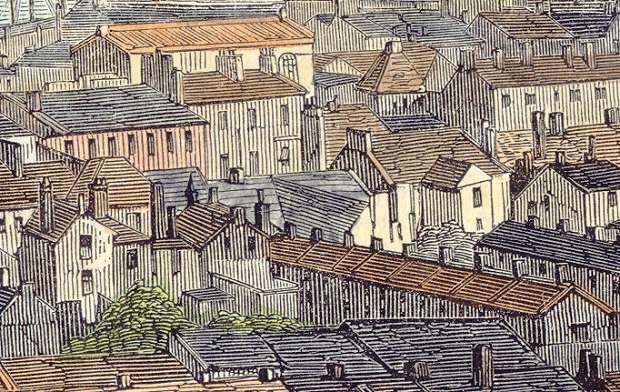
Hand-coloured wood engraving by Smyth (from a Daguerreotype), in Illustrated London News 19 Aug 1848 |
| Above: Swansea Town (detail). The population of the parish amounts to 33,972; of the borough to 41,606. The town has risen, with a rapidity unequalled in the history of the principality, from a comparatively insignificant place to a high degree of commercial and manufacturing importance; being indebted for its advancement and prosperity, not less to the mineral treasures abounding in its neighbourhood, than to its highly advantageous maritime situation. The number of tons of copper-ore smelted annually in the kingdom is estimated at about 200,000, nine-tenths of which are supposed to be manufactured in Swansea and its vicinity. (Black, 1869) |
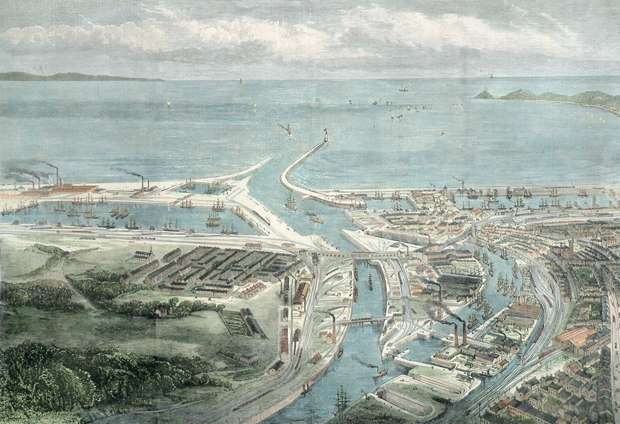
Hand-coloured wood engraving by Sulman, in Illustrated London News 22 Oct 1881 |
| Above: Swansea Harbour and Docks. The situation of the port is admirably adapted for carrying on an extensive commerce; and for its improvement very considerable sums are annually expended under the authority of acts of parliament. A judicious plan for enlarging this harbour, recommended by Captain Huddart, F.R.S, has been accomplished; a stone pier and embankment of about 300 yards having been built on the western side, and a similar pier of 600 yards on the eastern side, leaving an opening of 80 yards between the pierheads; thus forming an outer harbour capable of holding in perfect safety many hundred vessels. A lighthouse and a station for pilots have been erected on the western pier, rendering the entrance safe and convenient. (Black, 1869) |
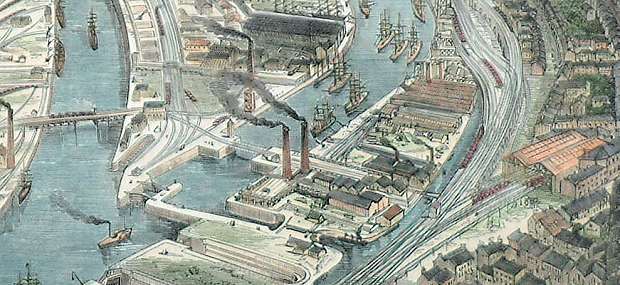
Hand-coloured wood engraving by Sulman, in Illustrated London News 22 Oct 1881 |
| Above: Swansea Harbour and Docks (detail). A portion of the harbour has been converted into a float, forming a basin of about ten acres; and commodious docks have, more recently, been constructed, capable of accommodating ships of the largest class. On the banks of the river, at Port Tennant, and at the New Cut, are spacious and commodious quays, bonded warehouses, stores, a dry dock, and a patent slip equal to the repairing of ships of 600 tons burthen. (Black, 1869) |
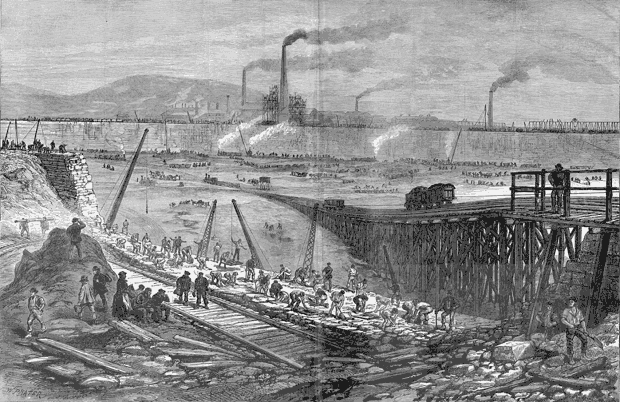
Engraving by W. Prater, in Illustrated London News 22 Oct 1881 |
| Above: "The New East Dock at Swansea, opened on Tuesday by the Prince of Wales." Increases in industrial output and in trade in copper, zinc, iron and tinplate combined with the developments in shipping (whereby steamships of greater tonnage were replacing smaller sailing vessels) meant that by the late 19th century Swansea's harbour was in desperate need of expansion. Such improvements were under the domain of the Swansea Harbour Trust and the result was the construction of the Prince of Wales Dock, the first on the east side of the river. It was 'opened' with great ceremony by the Prince and Princess of Wales (later Edward VII and Queen Alexandra) in 1881, but was not in fact completed until 1882. Owing to a continued increase in trade, even greater dock capacity became essential, so a further extension and a deepening of the channel entrance was made. By 1898 the extension had been completed. The whole North Quay frontage was now let to the GWR and the Rhondda & Swansea Bay Railway Company which linked the coalfields directly with the docks. This resulted in major increases in the export of coal from Swansea. During the late 19th century, the dock's heyday, it was one of the largest and busiest in Britain. (See swanseaheritage.net website) |
Monmouthshire
Right: Crumlin Viaduct, near Pontypool.
The wonderful viaduct at Crumlin, of which a view is given opposite, spans the valley of the Ebbw at the village from which it takes its name. Of this viaduct it may be said, without exaggeration, that few works in England are more interesting for their combination of mechanical skill and picturesque beauty. There are ten spans of 150 feet each, constructed of the extremely light and open iron-work known as "Warren's Girders". The piers, the loftiest of which is 204 feet high, consist of a framework of cast-iron tubes braced together and tapering from the base to the top, on which the girders rest. (Black, 1869) | | 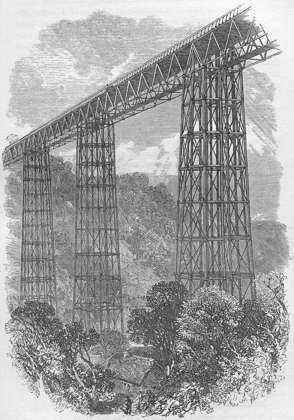
Unknown artist, in Black (1869) |
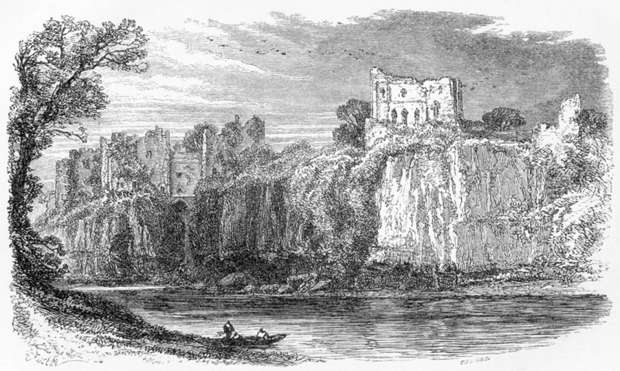
Unknown artist, in Black (1869) |
| Above: Chepstow Castle. The castle was founded in the 11th century by William Fitzosborn, Earl of Hereford, a relative of the Norman Conqueror. In the 13th century the greater part of the original structure was taken down, and one, larger and of greater strength, was erected. It is still a magnificent pile, towering upon the summit of a cliff whose base is washed by the classic Wye. (Black, 1869) |
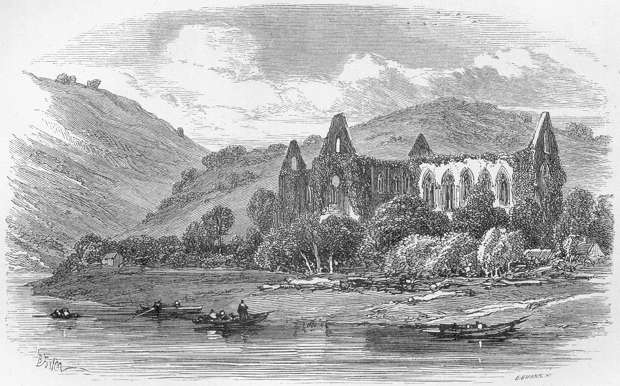
Unknown artist, in Black (1869) |
| Above: Tintern Abbey from the Wye. This majestic ruin, viewed in connection with the surrounding scenery, is justly esteemed the most beautiful and picturesque object on the banks of the Wye. It occupies a level area, beautifully screened on all sides by richly-wooded hills, amidst which the river pursues its winding course. The date of the foundation is the year 1131, when an abbey for Cistercian monks was founded here by Walter FitzRichard de Clare, and dedicated to St Mary. The principal portion of the ruins is the Church, which is a beautiful specimen of pure Gothic architecture. The whole is roofless, but the walls are almost entire, and some of the columns are still standing. (Black, 1869) |
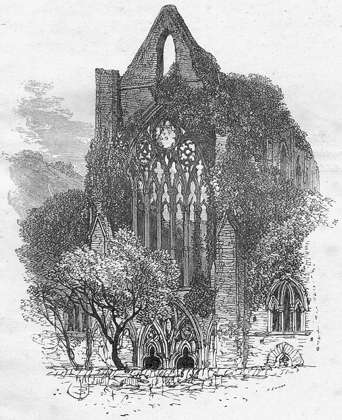
Unknown artist, in Black (1869) | | 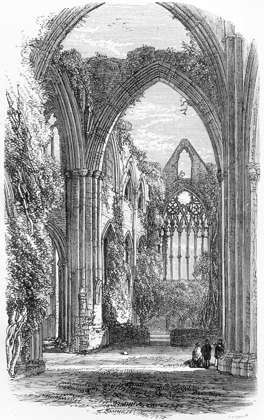
Unknown artist, in Black (1869) |
| Above: Tintern Abbey. | | Above: Tintern Abbey—interior. |
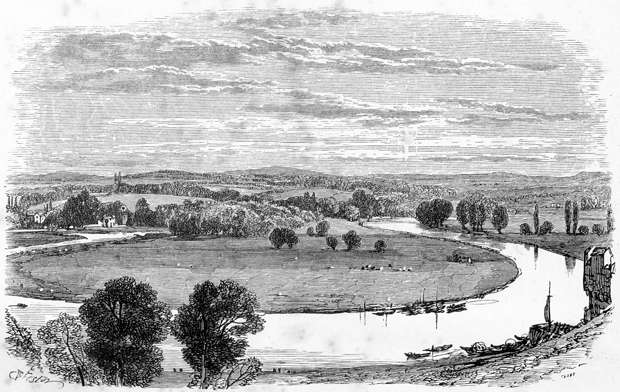
Unknown artist, in Black (1869) |
| Above: River Wye, from Ross-on-Wye. |
Pembrokeshire
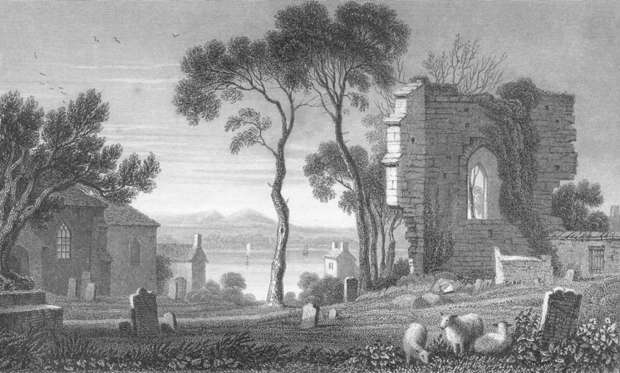
Unknown artist (circa 1800) |
| Above: St Dogmael's Abbey. This fragment of antiquity is much dilapidated, the few remaining potions being converted into barns and sheds. It is just possible to trace the outlines, and to ascertain that it was a structure of great extent, in the early Gothic style. This priory was founded for the reception of Benedictine monks by Martin de Tours, one of the military adventurers introduced by the Norman William. (Black, 1869) |
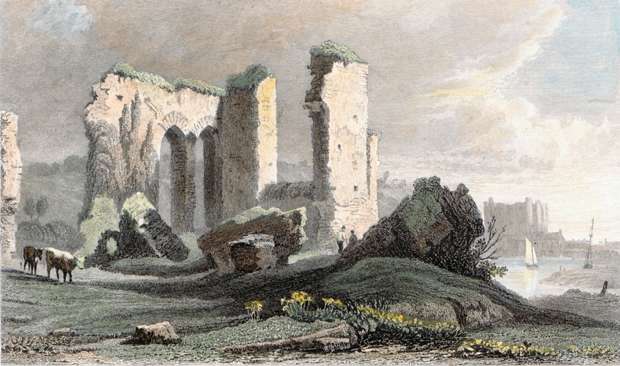
Engraved by J. Hinchliffe (circa 1800) |
| Above: The Priory, Haverfordwest. In a meadow at the extremity of the Parade are the ruins of a Priory, which was erected in the 12th century, and dedicated to St Mary and St Thomas. It was endowed, if not founded, by Robert de Hwlffordd, lord of this town, whose liberal grants of churches and lands were subsequently confirmed by Edward III. (Black, 1869) |
Back to Page 1
|
Images of Wales Back to Webpage Archive
Please write via my Contact Page with your comments about my photographs.
|